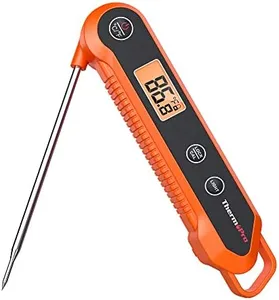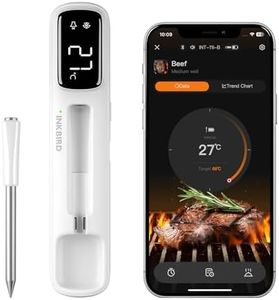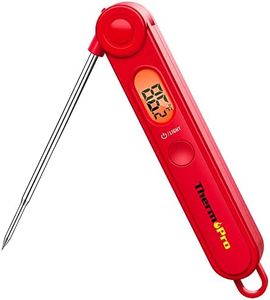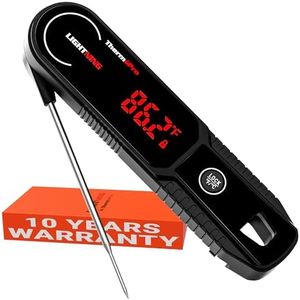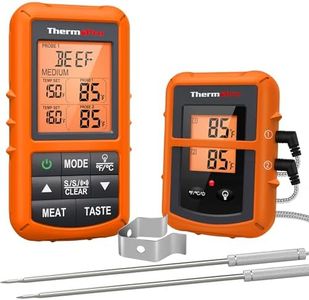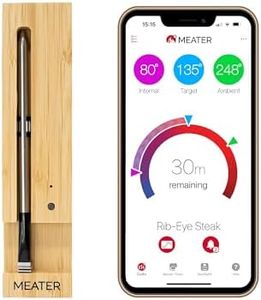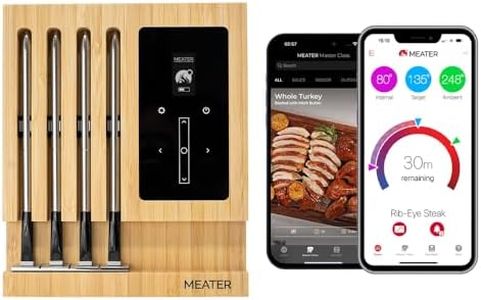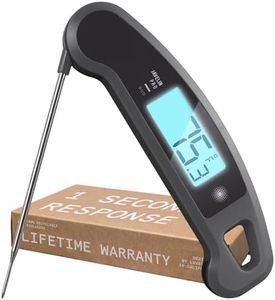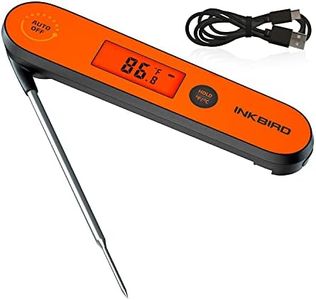We Use CookiesWe use cookies to enhance the security, performance,
functionality and for analytical and promotional activities. By continuing to browse this site you
are agreeing to our privacy policy
10 Best Chef Thermometer
From leading brands and best sellers available on the web.Buying Guide for the Best Chef Thermometer
Choosing the right chef thermometer can have a big impact on your cooking success. A good thermometer takes the guesswork out of knowing if your food is cooked at a safe and tasty temperature. There are different types and features to consider, each designed to suit various cooking styles. Before buying, think about how often you cook, what kinds of foods you prepare, and whether you want something quick and simple or more advanced with extra features.Type (Instant-read vs. Probe/Leave-in)When it comes to thermometers, there are generally two types: instant-read and probe (or leave-in) thermometers. An instant-read thermometer quickly gives you a temperature reading when inserted into food, usually within a few seconds, and is ideal for quick checks and spot-checking different parts of the meat. A probe or leave-in thermometer has a metal probe connected to a cord and monitor; it's designed to stay inserted in the meat while it cooks so you can keep track of the temperature over time. Instant-read thermometers are great for grilling or checking doneness right before serving, while leave-in models are handy for larger cuts and slow cooking. Think about whether you prefer to check temperatures during cooking or just at the end.
Temperature RangeThe temperature range tells you how hot or cold a thermometer can measure. For most cooking tasks, a range from about -20°C to 250°C (or -4°F to 482°F) will be more than enough. Lower ranges can be useful for candy-making or cold items, while higher ranges are needed for roasting or frying. Make sure the thermometer you pick covers the temperatures you most often need for your favorite dishes.
AccuracyAccuracy refers to how close the thermometer’s reading is to the actual temperature. For safety and perfect results, look for a thermometer that is accurate within ±1°C or ±2°F. Higher accuracy is especially important when cooking meat and poultry. If you cook at home and mainly grill or bake, high accuracy reduces the risk of serving undercooked or overcooked food. If you rarely cook meat, less strict accuracy may still work for general checks.
Speed (Response Time)Speed or response time measures how quickly the thermometer gives you a reading after being inserted into food. Fast-response models usually show a result in 2-5 seconds, while slower models may take up to 15 seconds. A quick thermometer is convenient, especially when grilling or frying, as you won’t need to hold your hand over the heat for long. For oven roasting or slow cooking, speed may not be as critical.
Display (Readability and Features)The display is where you read your temperature. A clear, large display is important for easy viewing, especially if you often cook in low-light kitchens or outdoors. Some thermometers have backlit screens and rotating displays so you can read them from any angle. If you often cook in varied lighting or need to read temperatures quickly, look for a well-lit display with big numbers.
Water Resistance and DurabilityWater resistance is about how well the thermometer can handle getting wet or splashed during use or cleaning. Cooking often involves steam, spills, or the need for a quick rinse, so a water-resistant or waterproof model lasts longer and can be cleaned more easily. If you’re likely to use the thermometer around liquids or outdoors, aim for one with at least some water resistance.
Additional Features (Timers, Alarms, Connectivity)Some thermometers include features like built-in timers, alarms when your food reaches a certain temperature, or even wireless connectivity so you can get updates on your phone. These add convenience, especially when cooking multiple dishes at once or if you like to keep an eye on things from another room. Choose based on how much automation and guidance you want during cooking.

